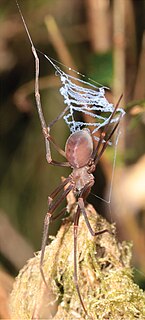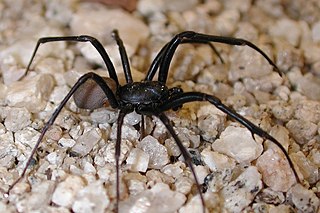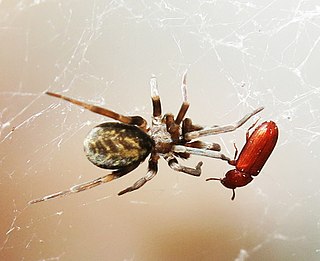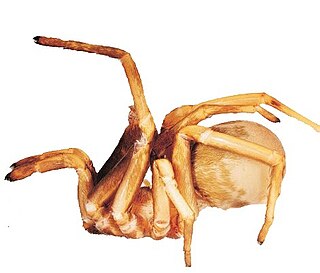
Crevice weaver spiders (Filistatidae) comprise cribellate spiders with features that have been regarded as "primitive" for araneomorph spiders. They are weavers of funnel or tube webs. The family contains 18 genera and more than 120 described species worldwide.

The southern house spider is a species of large spider in the family Filistatidae. Currently given the scientific name Kukulcania hibernalis, it was formerly known as Filistata hibernalis. Found in the Americas, it exhibits strong sexual dimorphism. It is occurs in the southern states of the USA, throughout Central America and some of the Caribbean, to southern Brazil, Uruguay and Argentina. The males may be mistaken for brown recluses because the two have similar coloration and body structure. However, compared to the brown recluse, male southern house spiders are typically larger in size, lack the distinctive violin shape on their cephalothorax, and have unusually long slender pedipalps. The females are dark brown or black and more compact. Both sexes may grow to be roughly 2 inches (5.1 cm) across, with the males typically having longer legs, and the females often having larger, bulbous bodies. The abdomen of the southern house spider is covered with fine velvety light gray hair.
Misionella is a genus of South American crevice weavers that was first described by M. J. Ramírez & C. J. Grismado in 1997. In 2005 a spider fossil found in 15- to 20-million-year-old Miocene amber from the Dominican Republic was described as Misionella didicostae. A second specimen was discussed soon thereafter.

Cribellum literally means "little sieve", and in biology the term generally applies to anatomical structures in the form of tiny perforated plates.
The Haplogynae or haplogynes are one of the two main groups into which araneomorph spiders have traditionally been divided, the other being the Entelegynae. Morphological phylogenetic studies suggested that the Haplogynae formed a clade; more recent molecular phylogenetic studies refute this, although many of the ecribellate haplogynes do appear to form a clade, Synspermiata.

The Entelegynae or entelegynes are a subgroup of araneomorph spiders, the largest of the two main groups into which the araneomorphs were traditionally divided. Females have a genital plate (epigynum) and a "flow through" fertilization system; males have complex palpal bulbs. Molecular phylogenetic studies have supported the monophyly of Entelegynae.
A crevice is a fracture or fissure in rock.

Plectreuridae, also called plectreurid spiders, is a small spider family confined to the Southwestern United States, Mexico, and the Caribbean. Only two living genera are known—the nominate genus Plectreurys and Kibramoa. In the past, the family was more widespread, with the Jurassic genus Eoplectreurys known from China, the Eocene Palaeoplectreurys baltica from Baltic amber and the Miocene Plectreurys pittfieldi from Dominican amber.

Crossopriza is a genus of cellar spiders that was first described by Eugène Louis Simon in 1893.

Pritha garfieldi is a species of araneomorph spiders in the family Filistatidae.
Filistata maguirei is a species of the araneomorph spider family Filistatidae.

Zaitunia akhanii is a species of the araneomorph spider family Filistatidae.

Sahastata sinuspersica is a species of the araneomorph spider family Filistatidae.

Artema is a genus of cellar spiders that was first described by Charles Athanase Walckenaer in 1837.

Alireza Zamani is an Iranian arachnologist and taxonomist.
Afrofilistata is a monotypic genus of African crevice weavers containing the single species, Afrofilistata fradei. It was first described by Pierre L.G. Benoit in 1968, and has been found in west and central Africa and in Sudan.
Lihuelistata is a monotypic genus of South American crevice weavers containing the single species, Lihuelistata metamerica. It was first described by M. J. Ramírez & C. J. Grismado in 1997, and has only been found in Argentina.
Pikelinia is a genus of South American crevice weavers that was first described by Cândido Firmino de Mello-Leitão in 1946.
Yardiella is a monotypic genus of Australian crevice weavers containing the single species, Yardiella humphreysi. It was first described by Michael R. Gray in 1994, and has only been found in Australia.
Labahitha is a genus of crevice weavers containing the single species, Labahitha oonopiformis. It was first described by S. L. Zonstein, Yuri M. Marusik & I. L. F. Magalhaes in 2017, and is only found in Malaysia.










